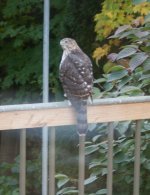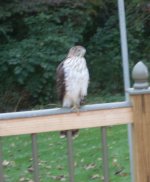hudakore
Member
Please pardon the poor quality of these photos. This hawk (coopers hawk?) has been coming around lately and my guess is that it's a young coopers hawk but it sits on the railing of the deck and continually caws(?) while flying from one railing to another. It has a very distinct cat's meow to it's call and has woken me up a couple of times. It just sits there "screaming". The first time I saw it, it was sitting on the deck and I thought it was wounded because it had its wings stretched out in a tent-like shape. Then I saw what looked like a dead sparrow near its feet.
Please confirm the identity, whether it's a young/immature bird and why this strange behavior.
Please confirm the identity, whether it's a young/immature bird and why this strange behavior.





